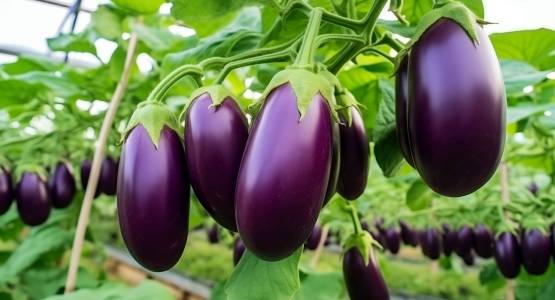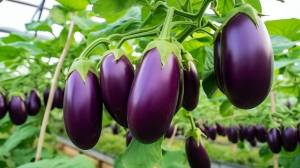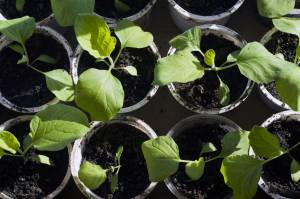How to Grow Aubergines in a Greenhouse in the UK: A Comprehensive Guide


This guide will cover everything you need to know about how to grow aubergines in a greenhouse in the UK, including selecting the right varieties, planting, caring for the plants, managing pests, and harvesting. Growing aubergines (also known as eggplants) in the UK can be a rewarding endeavour, particularly when using a greenhouse. The controlled environment of a greenhouse provides the warmth and protection these heat-loving plants need to thrive, making it possible to achieve a bountiful harvest even in the UK’s temperate climate.
Why Grow Aubergines in a Greenhouse?
Aubergines thrive in warm, stable environments, which can be challenging to maintain outdoors in the UK. Greenhouses provide several advantages:
- Controlled Temperature: Greenhouses trap heat, creating a consistently warm environment ideal for aubergines.
- Protection from Pests and Diseases: The physical barrier of a greenhouse helps protect plants from many pests and diseases common in outdoor gardens.
- Extended Growing Season: Greenhouses allow you to start growing earlier in the spring and extend the growing season into late autumn.
- Optimal Growth Conditions: With controlled humidity, watering, and ventilation, greenhouses offer the perfect conditions for healthy plant growth.
Choosing the Right Varieties
Not all aubergines are created equal, and selecting the right varieties is crucial for success in a UK greenhouse. Here are some recommended varieties:
- Black Beauty: A classic variety known for its large, glossy, dark purple fruits and robust flavour.
- Long Purple: This variety produces elongated fruits with a mild taste, perfect for grilling and frying.
- Thai Green: Known for its unique green skin and tender flesh, Thai Green is excellent for stir-fries and curries.
- Little Fingers: Produces small, slender fruits that mature quickly, making it ideal for shorter growing seasons.
- Rosa Bianca: An heirloom variety with beautiful lavender and white striped fruits, known for its creamy texture.
Propagating Aubergines
Starting your aubergines from seed is the most economical way to grow them. Here’s how to propagate aubergines effectively:
Sowing Seeds Indoors
- Timing: Start seeds indoors in late winter or early spring, about 8-10 weeks before the last expected frost date.
- Seed Trays or P

- Sowing Seeds: Sow seeds about 1 cm deep and cover lightly with compost. Aubergine seeds need warmth to germinate, ideally between 25-30°C.
- Watering: Keep the compost moist but not waterlogged.
- Germination: Place the trays in a propagator or cover with a plastic lid to maintain humidity. Seeds should germinate in 7-14 days.
Transplanting Seedlings
- Potting On: Once seedlings have two true leaves, transplant them into individual pots filled with potting compost.
- Hardening Off: Before moving seedlings to the greenhouse, harden them off by gradually acclimatising them to the greenhouse environment over 7-10 days.
- Transplanting to Greenhouse: When seedlings are 15-20 cm tall and all risk of frost has passed, transplant them into their final positions in the greenhouse.
Planting and Care
Proper planting and ongoing care are essential for healthy aubergine plants:
Planting Aubergines in the Greenhouse
- Soil Preparation: Prepare the greenhouse beds or containers with rich, well-draining compost. Incorporate organic matter, such as well-rotted manure or compost, to improve soil fertility.
- Spacing: Space plants about 45-60 cm apart to ensure good air circulation and room for growth.
- Staking: As aubergines grow, they can become top-heavy. Stake plants to provide support and prevent them from toppling over.
Watering and Feeding
- Consistent Moisture: Aubergines need consistent moisture to develop properly. Water plants regularly, keeping the soil evenly moist but not waterlogged.
- Feeding: Feed plants with a balanced liquid fertiliser every two weeks once they start flowering. Switch to a high-potassium fertiliser to promote fruit development.
Pruning and Training
- Removing Suckers: Remove side shoots (suckers) that appear in the leaf axils to direct energy to the main stem and fruits.
- Pinching Out: Pinch out the growing tips of the plant once it reaches about 45 cm in height to encourage bushier growth and more flowers.
- Supporting Fruits: As fruits develop, support them with string or small nets to prevent them from pulling the plant down.
Common Pests and Diseases
Even in a greenhouse, aubergines can be susceptible to pests and diseases. Here’s how to manage them:
- Aphids: Small, sap-sucking insects found on new growth. Control them with insecticidal soap or introduce beneficial insects like ladybirds.
- Whiteflies: Tiny white insects that fly up when disturbed. Use yellow sticky traps and introduce natural predators like Encarsia formosa.
- Spider Mites: Tiny mites causing fine webbing on plants. Increase humidity and use miticides or natural predators like Phytoseiulus persimilis.
- Botrytis (Grey Mould): Grey, fuzzy mould on leaves and stems. Improve ventilation, remove affected plant parts, and use fungicides if necessary.
- Powdery Mildew: White, powdery spots on leaves. Ensure good ventilation, avoid overhead watering, and use fungicides or neem oil.
Harvesting Aubergines
Knowing when and how to harvest aubergines ensures you get the best flavour and texture:
- Timing: Aubergines are typically ready for harvest 70-90 days after transplanting, depending on the variety.
- Signs of Ripeness: Harvest when the fruits are glossy and firm but before they start to soften. The skin should bounce back slightly when pressed.
- Method: Use a sharp knife or scissors to cut the fruit, leaving a short stem attached. Be careful not to damage the plant.
- Frequent Harvesting: Regularly harvesting ripe aubergines encourages the plant to produce more fruit.
Additional Growing Tips
- Succession Planting: To ensure a continuous supply of aubergines, start new seeds every 4-6 weeks during the growing season.
- Companion Planting: Grow aubergines alongside beneficial companions like basil, which can repel pests and improve flavour.
- Ventilation: Maintain good airflow in the greenhouse to reduce humidity and prevent fungal diseases. Open vents and doors during the day and consider using fans.
- Temperature Control: Aubergines prefer temperatures between 20-30°C. Use shading or ventilation to prevent overheating during hot summer days.
- Pollination: Although aubergines are self-pollinating, gently shaking the plants or using a small brush can help improve fruit set.
Enjoying Your Harvest
Aubergines are incredibly versatile in the kitchen. Here are some delicious ways to enjoy your harvest:
- Grilled Aubergine: Slice aubergines into rounds, brush with olive oil, and grill until tender and charred. Season with salt, pepper, and herbs.
- Aubergine Parmesan: Layer sliced aubergines with tomato sauce and cheese, then bake until bubbly and golden.
- Baba Ganoush: Roast or grill aubergines, then blend with tahini, garlic, lemon juice, and olive oil for a smoky dip.
- Ratatouille: Combine aubergines with other summer vegetables like tomatoes, courgettes, and peppers for a hearty, flavourful stew.
- Stuffed Aubergines: Hollow out aubergines and fill with a mixture of rice, vegetables, and spices, then bake until tender.
Conclusion
In our How to Grow Aubergines in a Greenhouse blog, we have found that it is a rewarding and enjoyable experience. With the right varieties, proper care, and attention to pest management, you can achieve a bountiful harvest of delicious, home-grown aubergines. Whether you’re a seasoned gardener or a beginner, these tips and techniques will help you make the most of your greenhouse and enjoy the fruits of your labour.

